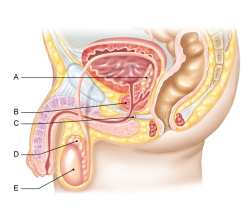A) follicle-stimulating hormone (FSH) promotes the development of estrogen-secreting follicles.
B) luteinizing hormone (LH) promotes the development of a progesterone-secreting corpus luteum.
C) the corpus luteum reaches its maximum size and progesterone output then shrinks.
D) there are high levels of both estrogen and progesterone.
E) ovulation occurs on each consecutive day.
Correct Answer

verified
Correct Answer
verified
Multiple Choice
Secondary sex characteristics in males develop due to the influence of
A) follicle-stimulating hormone (FSH) .
B) progesterone.
C) human chorionic gonadotropin (HCG) .
D) estrogen.
E) testosterone.
Correct Answer

verified
Correct Answer
verified
Multiple Choice
Which of the following mammalian structures is derived from one of the extraembryonic membranes?
A) placenta
B) uterus
C) ovary
D) cervix
E) labia
Correct Answer

verified
Correct Answer
verified
Multiple Choice
Which of these is mismatched?
A) ovulation - luteinizing hormone (LH) peaks
B) menstruation - follicle-stimulating hormone (FSH) peaks
C) secretory phase - progesterone peaks
D) menstruation - progesterone declines
E) proliferative phase - estrogen levels rise
Correct Answer

verified
Correct Answer
verified
Multiple Choice
The embryo (and later the fetus) is connected to the placenta by the
A) umbilical cord.
B) placental tube.
C) somite.
D) chorionic villi.
E) vas deferens.
Correct Answer

verified
Correct Answer
verified
Multiple Choice
The inner lining of the uterus is the
A) cervix.
B) endometrium.
C) placenta.
D) fimbria.
E) chorion.
Correct Answer

verified
B
Correct Answer
verified
Multiple Choice
If a woman has an untreated case of chlamydia, it may likely lead to
A) gummas.
B) liver failure.
C) buboes.
D) blisters on the genitals.
E) pelvic inflammatory disease.
Correct Answer

verified
Correct Answer
verified
Multiple Choice
Which STD is caused by a virus?
A) chlamydia
B) syphilis
C) trichomoniasis
D) gonorrhea
E) genital warts
Correct Answer

verified
Correct Answer
verified
Multiple Choice
Which of these cells is diploid (2n) ?
A) first polar body
B) spermatid
C) secondary oocyte
D) sperm
E) primary oocyte
Correct Answer

verified
Correct Answer
verified
Multiple Choice
Which of the following structures does not belong to the reproductive system?
A) oviduct
B) ovary
C) cervix
D) bladder
E) vagina
Correct Answer

verified
Correct Answer
verified
Multiple Choice
In the figure shown here, which of the following is the prostate gland? 
A) A
B) B
C) C
D) D
E) E
Correct Answer

verified
Correct Answer
verified
Multiple Choice
Animals with both male and female reproductive systems are
A) hermaphroditic.
B) chimeric.
C) parthenogenetic.
D) asexual.
E) menopausal.
Correct Answer

verified
Correct Answer
verified
Multiple Choice
If you could mark the ectoderm of a mouse embryo so that all tissues and organs descended from ectoderm were easily identifiable, where would you expect to find the marker?
A) skeletal muscles and dermis
B) cardiovascular and reproductive systems
C) nervous system and epidermis
D) lining of the digestive and respiratory tracts
E) urinary bladder and its lining
Correct Answer

verified
Correct Answer
verified
Multiple Choice
In which stage do the three germ layers form?
A) gastrula
B) blastocyst
C) neurula
D) morula
E) 8-cell stage
Correct Answer

verified
Correct Answer
verified
Multiple Choice
Sperm are produced
A) by Sertoli cells.
B) in the epididymis.
C) by interstitial cells.
D) in the seminiferous tubules.
E) in the seminal vesicles.
Correct Answer

verified
Correct Answer
verified
Multiple Choice
There is an old joke that goes, "What do you call a couple who practices coitus interruptus? Parents!" Is there any truth to this joke?
A) Yes, because coitus interrupts is only practiced by couples who already have children.
B) No, because coitus interruptus is the most effective means of birth control.
C) Yes, because coitus interruptus is one of the least effective means of birth control.
D) No, because coitus interruptus is not only a highly effective means of birth control, it also protects against STDs.
E) Yes, because a coitus interruptus is only effective if carefully inserted before intercourse.
Correct Answer

verified
C
Correct Answer
verified
Multiple Choice
Which lifestyle is most likely to lead to infertility in a male?
A) a man who is a semiprofessional athlete
B) a man who works as a computer programmer and sits at a desk the majority of the day
C) a man who works as an mechanic
D) a man who works for a company that applies pesticides to lawns
E) a man who works as a teacher
Correct Answer

verified
Correct Answer
verified
Multiple Choice
Which of these places the events of the menstrual cycle in the correct order?
A) menstrual phase→secretory phase→proliferative phase→ovulation
B) menstrual phase→ovulation→secretory phase→proliferative phase
C) menstrual phase→proliferative phase→ovulation→secretory phase
D) menstrual phase→proliferative phase→secretory phase→ovulation
E) menstrual phase→ovulation→proliferative phase→secretory phase
Correct Answer

verified
Correct Answer
verified
Multiple Choice
A pregnant woman has passed her due date, and her cervix is dilated. This indicates which stage of childbirth?
A) first
B) second
C) third
D) fourth
E) fifth
Correct Answer

verified
A
Correct Answer
verified
Multiple Choice
The hollow, fluid-filled ball of cells that develops from the morula is the
A) neurula.
B) zygote.
C) somite.
D) blastocyst.
E) gastrula.
Correct Answer

verified
Correct Answer
verified
Showing 1 - 20 of 55
Related Exams